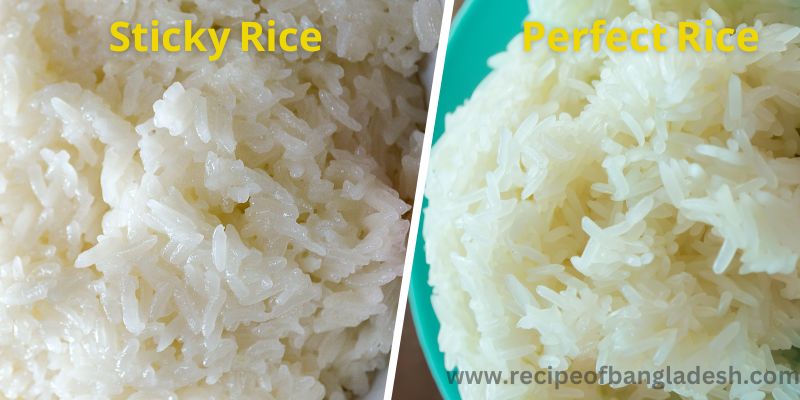Have you ever cooked a pot of rice only to find that it turned out sticky and clumpy instead of fluffy and separate? Sticky rice is a common problem that can be caused by a variety of factors, including overcooking, using too much water, also not soaking and rinsing the rice before cooking.
In this article, I will explore some common causes of sticky rice and provide you some tips how can you cook perfectly non-sticky rice every time.
Whether if you are a seasoned pro or a beginner in the kitchen, this article will help you how to fix the issue of sticky rice.

The Importance of Non-Sticky Rice
Steamed Rice is a very common food around the world including Bangladesh. It’s often served as a main dish sometimes used as a base for other dishes like curries, beef, chicken curry or vegetable curry. When cooked properly, rice should be fluffy and individual grains should be separate and distinct. On the other hand, sticky rice is difficult to serve and can ruin the overall presentation of a dish. That’s why Its always important to cooking of perfect non-sticky rice.
Causes of Sticky Rice
Here I will discussed about some common causes of sticky rice.
Overcooking Rice
One of the most common causes of sticky rice is overcooking. When rice is overcooked, the grains break down and release excess starch, which can cause the rice to become sticky. To prevent this, be sure to follow the cooking instructions on the package or recipe and if you cook set a timer to ensure that the rice is not overcooked. Besides if you have no option to set the timer then always stay on their.
Using Too Much Water
Using too much water during the cooking process can also cause rice to become sticky. The excess water can cause the grains to break down and release starch, resulting in a sticky consistency. To fix this, be sure to use the correct ratio of water to rice.
Water ratio will vary depending on the type of rice you are using and the method of cooking. but a general rule of thumb is to use 1 and 1/2 to 2 cups of water for every cup of white rice, and 1 and 3/4 to 2 and 1/4 cups of water for every cup of brown rice.
Here I add a table for perfect water Ratio for all kind of rice
| Type of Rice | Water-to-Rice Ratio |
| White, long-grain | 2 cups water for every 1 cup rice |
| White, medium-grain | 1 and 3/4 cups water for every 1 cup rice |
| White, short-grain | 1 and 1/2 cups water for every 1 cup rice |
| Brown, long-grain | 2 and 1/4 cups water for every 1 cup rice |
| Brown, medium-grain | 2 cups water for every 1 cup rice |
| Brown, short-grain | 1 and 3/4 cups water for every 1 cup rice |
| Jasmine | 1 and 3/4 cups water for every 1 cup rice |
| Basmati | 1 and 1/2 cups water for every 1 cup rice |
| Wild | 3 cups water for every 1 cup rice |
These ratios are for cooking rice on the stovetop. If you are cooking rice in a rice cooker or in the microwave, the water-to-rice ratios may vary. Always refer to the manufacturer’s instructions for the correct water-to-rice ratio.
On the other hand, if you are not using the absorption method of rice cooking, you can use too much water if you are using the pasta method, also known as the classic method for perfectly cooking rice. In this method, you can use unmeasured water. After the rice has boiled and become soft, drain the rice water in a strainer.
At the bottom of the article, I will give you a video tutorial for both ways of cooking rice.
Using The Wrong Type of Rice
Different types of rice have different levels of starch and can have varying results when it comes to stickiness. For example, short-grain rice tends to be stickier than long-grain rice. If you are having trouble with sticky rice, try experimenting with different types of rice to see which one works best for you.
Not Rinsing Rice Before Cooking
Rinsing rice before cooking can help to remove excess starch, which can contribute to stickiness. To rinse rice, place it in a fine-mesh sieve and run cold water over it until the water runs clear.
How to Fixes Sticky Rice
Here, I will give you more detailed instructions based on my personal experiences on how to fix sticky rice after it has been cooked:
- Break up any clumps: If the rice has formed clumps, use a fork to gently break them up. Be careful not to overmix the rice, as this can make it even stickier.
- Add a little oil or butter: If the rice is too sticky, try adding a little oil or butter to it. This can help to coat the grains and prevent them from sticking together. Use just a small amount, as too much oil or butter can make the rice greasy.
- Spread the rice out: If the rice is still sticky after adding a little oil or butter, try spreading it out on a baking sheet. This allows the steam to escape and helps to prevent the rice from becoming sticky.
- Dry the rice out: If the rice is still too sticky, try placing it in a dry pan over low heat. Cook the rice, stirring occasionally, until it becomes dry and fluffy. This may take a few minutes, so be patient.
- Add a little water: If the rice is too dry after cooking it in the pan, try adding a little water to it. This can help to rehydrate the rice and make it more tender. Add the water a little at a time, stirring well after each addition, until the rice is the desired consistency.
- Serve the rice: Once the rice is no longer sticky, it is ready to be served. Enjoy!
Some Common Tips For How Can You Cook Perfectly Non-Sticky Rice
- Use the proper ratio of water to rice
- Don’t overcook the rice
- Soak rice overnight
- Rinse soaked rice before cooking
- Experiment with different types of rice
See the video tutorial
Final Thoughts
After read the full article I hope you find the right answer why your rice is sticky. If you want to cook perfectly non-sticky rice every time, follow the above tips and see which one works best for you. By following these tips, you should be able to achieve perfectly fluffy, non-sticky rice every time.
I would greatly appreciate it if you shared my thoughts with your friends and family. If you have any questions, please leave a comment below.

Leave a Reply